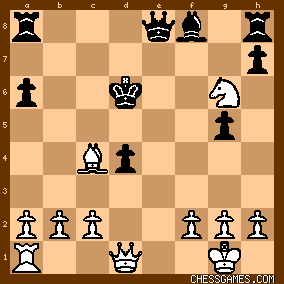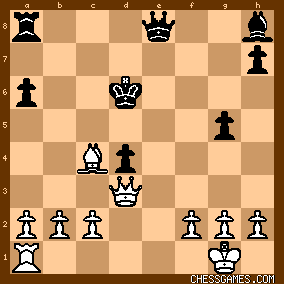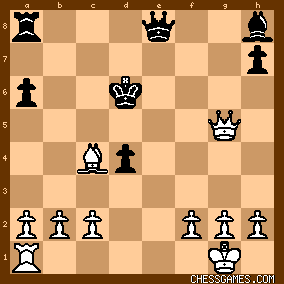|
< Earlier Kibitzing · PAGE 3 OF 3 ·
Later Kibitzing> |
| Jul-09-11 | | morfishine: <scormus> I don't feel so bad as I went with <17.Nf4> too (along with <Patriot>) which forces black to surrender an exchange. The key here is can white now at least draw?
I left you a message at yesterdays POTD (regarding ranks) that may relieve some of your discouragement. |
|
Jul-09-11
 | | Jimfromprovidence: As <Once> stated earlier, the position in which black takes the sacrificed bishop offer is very tricky to analyze. <tacticalmonster> had this interesting line. <17 Bg5 fxg5 18 Rxe5 Kd7 19 Rxe6! Kxe6 20 Nf4++ Kd6 21 Nxg6 hxg6 22 Qxh8- White is simply up two pawns with an attack against Black's exposed king>. But what happens if black plays 21...Qe8 instead?

click for larger viewWhite's knight is pinned as black threatens 22...Qxg6. It took me quite a while to figure out a winning path for white and I believe that there are three different first moves for him to get there. |
|
Jul-09-11
 | | LIFE Master AJ: <<<Jul-09-11
Jimfromprovidence: As <Once> stated earlier, the position in which black takes the sacrificed bishop offer is very tricky to analyze.> But what happens if black plays 21...Qe8 instead?>> I'd say 22.Qg4!, Qxg6; 23.QxP/d4+ (I even checked it with Fritz.) |
|
| Jul-09-11 | | James Bowman: <<Jambow> I don't know if I'm any stronger so I looked at a possible line and verified it with Houdini.> Thanks <patriot> I see perhaps black could survive with correct play then the material advantage would even it up. Thanks for looking I can't use engines on this computer and the attack looks promising for white. |
|
| Jul-09-11 | | James Bowman: <STST> <23.Bxf6 Qxf6> at this point in your sequence I think Bd3 attacking the pinned knight on g6 keeping more material and not centralizing blacks Queen looks better. Never mind shallow patzer just found a refutation ;o] Oh well if it were easy we would all be grand masters. |
|
| Jul-09-11 | | wals: 17.Nxf6, -1.22, blunder.
Dr Nunn was right on the money.
Analysis by Rybka 4 x64: d 21 : 1hr 29 min
1.  (1.13): 17.Bg5 Bxd5[] 18.Rxe5+ fxe5 19.Bxd8[] Rxd8 20.Bxa6 Bg7 21.Bd3 0-0 22.f3 Rd6 23.a4 e4 24.fxe4 Nf4 25.Qf3 Bc6 26.a5 Rh6 27.Rf1 Be5 28.Rf2 Kh8 29.Bc4 Ne6 30.Qa3 Bxh2+ 31.Kf1 Rxf2+ 32.Kxf2 (1.13): 17.Bg5 Bxd5[] 18.Rxe5+ fxe5 19.Bxd8[] Rxd8 20.Bxa6 Bg7 21.Bd3 0-0 22.f3 Rd6 23.a4 e4 24.fxe4 Nf4 25.Qf3 Bc6 26.a5 Rh6 27.Rf1 Be5 28.Rf2 Kh8 29.Bc4 Ne6 30.Qa3 Bxh2+ 31.Kf1 Rxf2+ 32.Kxf2 2.  (0.63): 17.Nf4 Bxc4 18.Nxg6[] hxg6 19.Qxh8[] Kd7 20.Bf4 Bd6 21.Qg7+ Qe7 22.Qxe7+ Bxe7 23.Bxe5 fxe5 24.Rxe5 Rb8 25.b3 Bf6 26.Ree1 Be6 27.Rad1 Bf5 28.Rd2 Rc8 29.c4 Kc6 30.f3 d3 31.g4 Bc3 32.Red1 (0.63): 17.Nf4 Bxc4 18.Nxg6[] hxg6 19.Qxh8[] Kd7 20.Bf4 Bd6 21.Qg7+ Qe7 22.Qxe7+ Bxe7 23.Bxe5 fxe5 24.Rxe5 Rb8 25.b3 Bf6 26.Ree1 Be6 27.Rad1 Bf5 28.Rd2 Rc8 29.c4 Kc6 30.f3 d3 31.g4 Bc3 32.Red1 |
|
| Jul-09-11 | | solskytz: doesn't 17. Bg5 Bxd5 lead to 18. Rxe5+ winning the d5 bishop? |
|
| Jul-09-11 | | BiteByBits: very nice game i did not see Bg5... |
|
Jul-09-11
 | | An Englishman: Good Evening: Oh, well--winning streak ends at 12. |
|
| Jul-09-11 | | sevenseaman: In terms of time you may not be able to imagine the effort I put in to get a win for White. I wrestled all day with Crafty but did not succeed against the weirdly good defense responses it finds to any new attack ideas. I had noted <tacticalmonster>'s line; <a) 17 fxg5 18 Rxe5 Kd7 19 Rxe6! Kxe6 20 Nf4++ Kd6 21 Nxg6 hxg6
22 Qxh8- White is simply up two pawns with an attack against Black's
exposed king>
For me, it had already been refuted by Crafty when it played 21...Qe8 rather than hxg6, as noted by <jimforprvidence> too. 
click for larger view In the labyrinths of long analysis, I do think I came across situations where White could force a draw by repetition but I wasn't too intent upon merely a draw. I'd be interested if any line leading to a White win is found. Though I did try some different ideas, most of my effort was based on <21. Bg5>. The win aspect could unfold following some newer idea. We should not be biased merely because GM Nunn endorses <21. Bg5> as the best move. <morfishine> Thanks. You are being kind and partial to me in saying I latched on to <21. Bg5>. Its an idea most solvers have hit upon rather easy. There are other ideas almost as valid.
<Once> has posted some that have been verified by Fritz and appealed to me. |
|
Jul-09-11
 | | Peligroso Patzer: <Once: <Peligroso Patzer> Yes, I wondered about Nunn's comments too. What I think he meant to say was that <after 17. Nxf6+> black has a clear advantage. This would fit with his statement - "as the three pawns do not provide enough compensation for the piece" - which only really applies after 17. Nxf6+. *** > Good observation. I think you are correct. Something about the phrasing of Nunn's comment (probably the fact that he spoke of Black's having an advantage, rather than White's moving leaving Black with an advantage) implied to me that he was referring to the position before White's 17th, but it does not literally say that. The comment does make sense with respect to the position <after> <17.Nxf6+?>. |
|
| Jul-09-11 | | Anatoly21: Interestingly, I found that 14.Qh5 to be an inaccuracy. 14.Ne4! is much better. For example, 14.Ne4 Ng6 15.Bd5 Bb7 16.Re1, giving White tremendous initiative and two pawns for the piece, since 16...Nge5 meets 17.f4 f5 18.Qh5+, giving White his third pawn and no loss of initiative. Just something to add to the analysis. |
|
| Jul-09-11 | | jheiner: 17.White to play? Leonhardt vs C Jaffe, 1911 Very Difficult Material: 2P for N.
Development: White is castled with some protection. Nf3+ is possible. Black's K is in the center and pawn structure has been destroyed.
For White: Nd5 is hanging. Bc4 is loose.
For Black: Ng6 is pinned. Ne5 is loose. Be6 is loose.
Candidates: Nc7, Nxf6+, Rxe5, Bh6, f4
This is a complex tactical position with many choices and move orders. I'd rather not sit here and try to grind through every combination to arrive at the solution. So what's the strategy?
As White, I would like to liquidate the center with tempo, and bring my heavy pieces to bear which should be enough. Let's look at a fairly forcing line: 17.Nxf6+ Qxf6 18.Bg5 Qf5 (or 18...Qf7) (18...Nf3+ 19.gxf3 Qf5 doesn't work.) 19.Bxe6 Qxe6 Materially, White is down 2N for 3P, but both the Ne5 and Ng6 are pinned. The Qe6 is also in the line of the pin. All of White's pieces are developed. Black cannot castle long due to the Bg5
. 20.f4 (threatening 21.Rxe5 and winning the Q)
Then what? If 20...Bd6
I looked seriously at:
A.21.fxe5 Bxe5 22.Re1 O-O
B.21.Rxe5! Bxe5 22.Re1 O-O
and the O-O removes a lot of threats.
21.f5! Qf7 22.fxg6 Qxg6 23.Rxe5+ Bxe5 24.Qxe5+
with mate threats, dark square domination, attacks on Rh8. Materially, White is now a R for B, but will win a R shortly. I would love to look at lines with Bh6 as well, since that's been the key line all week, but calling time. Time to check...
Wow! I got the first four moves exactly right. Black replied Bg7 instead of Bd6 and then White captures fxe5... Which I did NOT like because Black immediately captures, it removes the attacking tempos, and White LOSES! I preferred f5 to keep the attack going. Now MUST read the kibitzing to see if I had the right line... |
|
| Jul-09-11 | | abuzic: <wals: Analysis by Rybka 4 x64: d 21 : 1hr 29 min....
1. 17.Bg5 Bxd5[] 18.Rxe5+ fxe5 19.Bxd8[] Rxd8 20.Bxa6 Bg7 21.Bd3 0-0 22.f3 Rd6 23.a4 e4 24.fxe4 Nf4 25.Qf3 Bc6 <26.a5 Rh6> 27.Rf1 Be5 <28.Rf2 Kh8> <29.Bc4 Ne6> 30.Qa3 Bxh2+ 31.Kf1 Rxf2+ 32.Kxf2>
In the above line, the following alternatives worth consideration: 1. On <26. a5 Rh6>: 26. a5 Rg6 1. On <28 Rf2 Kh8>: 28. Rf2 Nh3+ 2. On <29. Bc4 Ne6>: 29. Bc4 Rhf6! (29. Qg4 looks better) |
|
| Jul-09-11 | | WhiteRook48: I looked at 17 Nf4 instead. |
|
| Jul-09-11 | | jheiner: Nope. Board vision fell apart. 21.f5?? Qxf5. But I was pretty deep in it at that stage. Oh well. Weird puzzle today. |
|
| Jul-09-11 | | sevenseaman: <stst> You posted a brave effort and I tried it. It fails against best defense.
Try 21... Rc8 instead of 21...Be7 and Black's counterattack gains a foothold. Advance f4 later makes g2 a target and Black Q and the c8 R combine to put White under unrelieved pressure. Typo; In my earlier comment I've printed <21. Bg5> rather than <17. B g5>. Please try and bear with me. Age catching up? I forget the context but I remember some reference to 'senility' by <Once> a few days ago. A young, beautiful starlet reneged on her marriage to an old billionaire only a couple of months into conjugal experience. Reason given; 'I couldn't stand the idea of senility creeping over me of a sudden'. |
|
Jul-09-11
 | | Jimfromprovidence: As I stated in my earlier query, the line 17 Bg5 fxg5 18 Rxe5 Kd7 19 Rxe6! Kxe6 20 Nf4++ Kd6 21 Nxg6 Qe8 is a definite win for white and there are three ways to get there.
click for larger view<LIFE Master AJ> found one way, 22 Qg4. There is also 22 Qd1 below, (which is the same tactically as 22 Qg4). 
click for larger viewNote the position of black's h rook. It is en prise and has no escape square. White threatens both 23 Qxd4+, winning the rook, or 23 Nxh8 directly. Black cannot defend both threats at once. In summary, white wins by attacking the d pawn with check after either 22 Qg4 or 22 Qd1. The third way is after 22 Qf3!?, which is a bit unorthodox and less staightforward, but it still gets the job done. |
|
| Jul-09-11 | | TheBish: Leonhardt vs C Jaffe, 1911 White to play (17.?) "Very Difficult"
White is down a piece for two pawns, so obviously White sacrificed for this attack. Seems to be worth it, as Black's king is stuck in the center, and there are two pins by White's rook and queen. How about a third pin? 17. Bg5!
So that if 17...fxg5 18. Rxe5 is very strong.
If 17...Nxc4 18. Nxf6+ looks very strong. That's all the time I have, time to check it out. |
|
| Jul-09-11 | | sevenseaman: <jimforprovidence> <the line 17 Bg5 fxg5 18 Rxe5 Kd7 19 Rxe6! Kxe6
20 Nf4++ Kd6 21 Nxg6 Qe8 22. Qg4/Qd1 is a definite win for White> The defense line should be 22...Bg7 rather than capturing
the g6N immediately. It possibly could be a tenuous win in
the long run. There is no gainsaying the idea. |
|
| Jul-10-11 | | CHESSTTCAMPS: White has invested a piece to get two pawns and a strong attack on the uncastled black king, marked by powerful pins on the black knights. How does white respond to the primary threat of Bxd5 without losing the initiative? The current inactivity of the queenside rook and bishop suggests a candidate that increases the pressure on the e-file: 17.Bg5!!
Putting a 3rd minor piece en prise poses major problems for which there is no good answer: A) 17... fxg5 18.Rxe5 Kd7 (or f7) 19.Rxe6! Kxe6 20.Nf4+ Kd7 21.Nxg6 hxg6 22.Qxh8 and white has regained the material spent, keeping a 2-pawn lead and ongoing attack against the exposed king. A.1) 18... Qd7 (and others) 19.Rxe6+ wins
B) 17... Bxd5 18.Bxd5! (the tempting 18.Rxe5+ leaves black in good shape after 18...fxe5 19.Bxd8 Rxd8 20.Bxd5 Rxd5 with R+B+N for a Q and solid center) 18...fxg5 19.Rxe5+ Kd7 20.Re6! Nf4 21.Qf7+! Be7 22.Rxf6 looks strong B.1) 18... Qxd5 19.Bxf6 and he double threat of 20.Bxh8 and Rxe5+ is winning. B.2) 19... Be7 20.Bxa8 Qxa8 21.Rae1 and white is in control. B.3) 20.Re4 also offers strong pressure against the BK and 3 pawns for a piece C) 17... Nxc4 18.Rxe6+ followed by Bxf6 appears winning. I think this is it - time for review. I've probably seen this long ago. |
|
| Jul-10-11 | | CHESSTTCAMPS: Did not consider 21... Qe8 in my A-line (Crafty EGT's defense), but white still has good chances. Interesting stuff! |
|
Jul-10-11
 | | Jimfromprovidence: From my most recent post... the line 17 Bg5 fxg5 18 Rxe5 Kd7 19 Rxe6! Kxe6 20 Nf4++ Kd6 21 Nxg6 Qe8 22. Qg4/Qd1 is a definite win for White. <sevenseamen> disagrees. He says <The defense line should be 22...Bg7 rather than capturing the g6N immediately. It possibly could be a tenuous win in the long run. There is no gainsaying the idea.> Nothing tenuous at all dear chap. After 22 Qd1 Bg7 23 Nxh8 Bxh8 24 Qd3, white is up two pawns and will win either the a or h pawn next move.

click for larger viewIf 22 Qg4 instead, 22...Bg7 is a an even worse move as 23 Nxh8 Bxh8 24 Qxg5 puts white up by a clear three pawns one move earlier. 
click for larger view |
|
Jul-10-11
 | | NM JRousselle: Once again the piece defeats the 3 pawns in the ending. I have been trying to convince people (for centuries, it seems) that the piece is very often superior to the pawns. Some people never listen... |
|
| Jul-10-11 | | ughaibu: When did white have three pawns, for the piece, in the ending? |
|
 |
 |
|
< Earlier Kibitzing · PAGE 3 OF 3 ·
Later Kibitzing> |





































